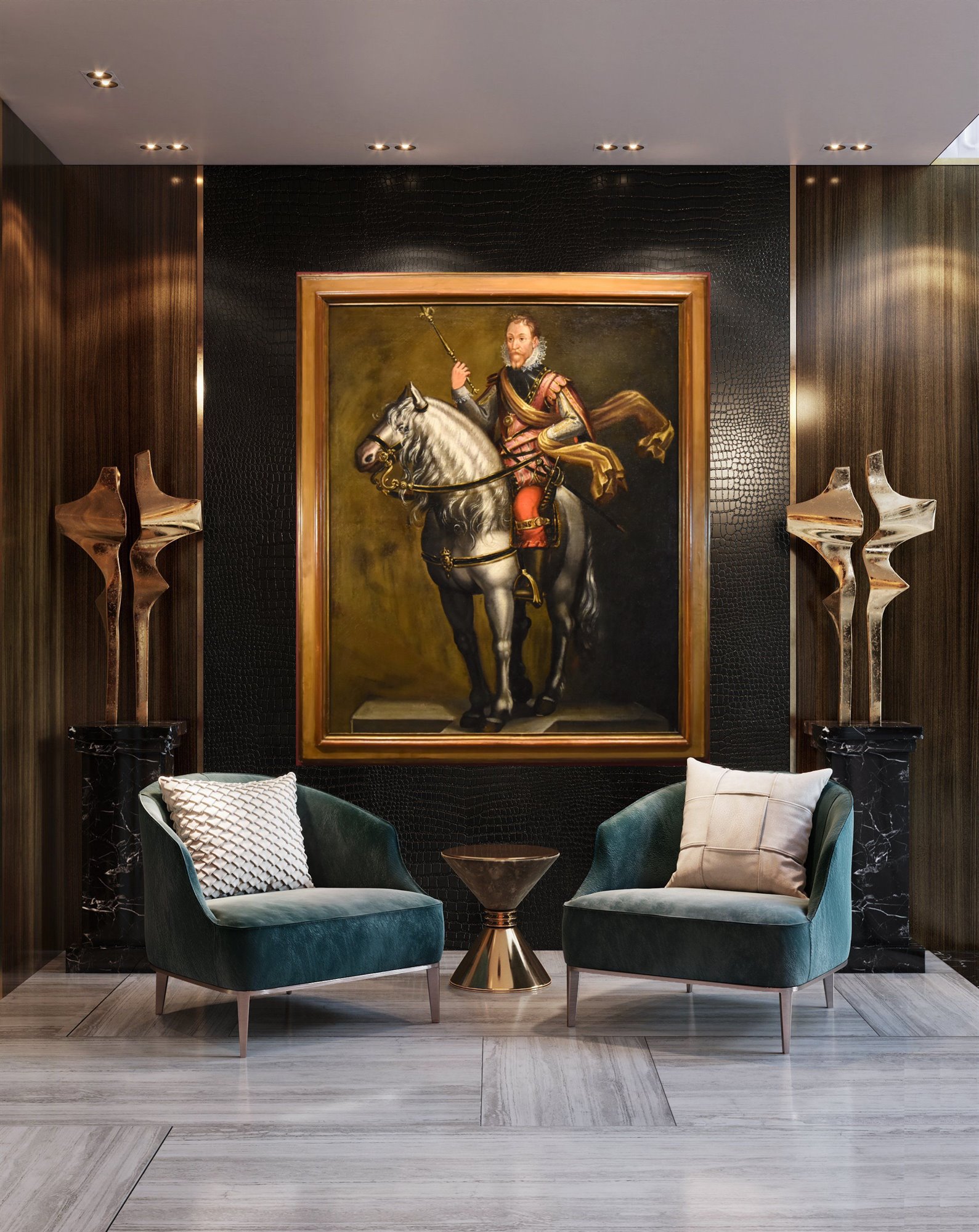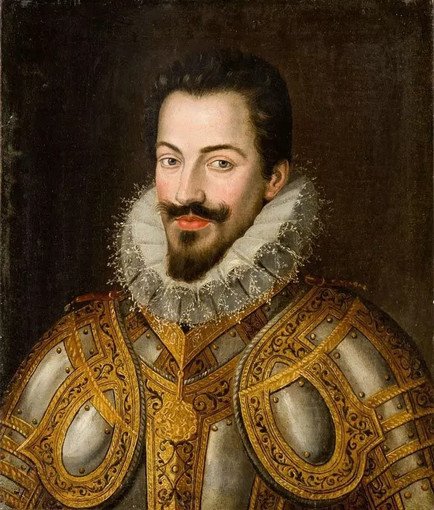Ritratto equestre di Carlo Emanuele I, Duca di Savoia (Rivoli 1562 - Savigliano 1630)
Jan Kraeck (Haarlem 1540 circa – Torino 1607) Bottega di
Jan Kraeck, in Italy Giovanni Caracca
(Haarlem c. 1540 - Turin 1607)
Workshop of
Equestrian portrait of Charles Emmanuel I, Duke of Savoy (Rivoli 1562 - Savigliano 1630) known as 'the Great'
Oil on canvas
148 × 122 cm - Framed 165 × 139 cm
The work is also accompanied by an expert's report by Dr. Arabella Cifani, which traces it back to a pupil of the master, Giulio Maino (1570 - after 1643)
The subject of this fascinating equestrian portrait is Charles Emmanuel I, Duke of Savoy (Rivoli 1562 - Savigliano 1630), immortalised in adulthood, proudly mounted on the back of his white horse, in his sumptuous ceremonial armour trimmed with fine gold ornaments. He wears short hair, a pointed beard and moustache, with a lace ruff around his neck.
Nicknamed 'Firehead' by his subjects, due to his manifest military aptitude and impetuous character, he was one of the most capable and cultured princes in the history of the House of Savoy; his birth was announced to the family by Nostradamus, in 1561, who added that he would become 'the greatest leader of his time'.
He married the daughter of Philip II of Spain, Catherine Michela, confirming the traditional link of his lineage with the Habsburgs of Spain.
Ambitious and self-confident, thanks to the excellent state of the Duchy he had inherited from his father, he sought to expand his power territorially: he left the Duchy of Savoy an administrative, diplomatic and military organisation of an efficiency and solidity never known in the past, achieved with the contribution of the Piedmontese officials he surrounded himself with. Turin was enriched with churches, palaces and monuments, and the Savoy court became Italy's leading cultural centre thanks to intellectuals from all over the peninsula.
Our fine portrait stands out for the pose of the valiant noble knight who sits firmly on the back of his steed and holds the staff of command.
The armour, in its sumptuousness and richness, recalls those in use at the Spanish court and with the Habsburgs, as shown by the portraits of artists working for Spanish kings between the 16th and 17th centuries: for example, the famous Charles V on horseback by Titian (1548, Prado Museum), the Equestrian Portrait of Charles V of Habsburg (c. 1620, Uffizi, Florence) and the Portrait of Charles I of England (1640, Prado Museum), both by Van Dyck, with a type of portrait that glorified and emphasised the strength and magnificence of the immortalised ruler.
The work is undoubtedly by an artist/collaborator from the workshop of the Flemish painter Jan Kraeck (Haarlem 1540 - Turin 1607), known by the Italianised name of Giovanni Caracca, who was mainly active as a painter at the Savoy court, working both in the service of Emanuele Filiberto I and for his son Carlo Emanuele I of Savoy between 1568 and 1607, and engaged in the most important works promoted by the dynasty.
During his stay at the Savoy court, Caracca produced numerous portraits, and in particular we must mention the series dedicated to the depiction of the entire genealogy of the Counts and later Dukes of Savoy, commissioned at the beginning of the 17th century by Charles Emmanuel I for his Grand Gallery (which united the Castle and the Ducal Palace), which were however destroyed by fire in 1659.
The equestrian portrait of Charles Emmanuel I, in particular, was in fact replicated by Caracca and his workshop on several occasions, one of which was for the Great Gallery, for which he also painted the image of his father Emmanuel Philibert I. This series of canvases, with portraits strictly on horseback, as Caracca himself had designed, was initially intended to appear above the wardrobe cupboards, with the effigies standing out majestically from the top of the great corridor.
Our painter's portrait production was strongly influenced by his encounter with the artists working at the Spanish court in 1585, on the occasion of the wedding between Charles Emmanuel I and the Enfanta of Spain, Catherine Michela, daughter of Philip II. His encounter with the portrait painters at the Spanish court oriented his production, initially based only on the model of late 16th century French portraiture, towards the canons of the 'International Court Portrait' with a focus on the painting of Alonso Sanchez Coello and Antonio Moro.
ADDITIONAL INFORMATION:
The painting is sold complete with an attractive antique gilded frame and is accompanied by a certificate of authenticity and descriptive iconographic card.
We take care of and organise the transport of the purchased works, both for Italy and abroad, through professional and insured carriers.
Should you have the desire to see this or other works in person, we will be happy to welcome you to our new gallery in Riva del Garda, Viale Giuseppe Canella 18. We are waiting for you!
Contact us for any information or to arrange a visit, we will be happy to answer you.
Follow us also on:



